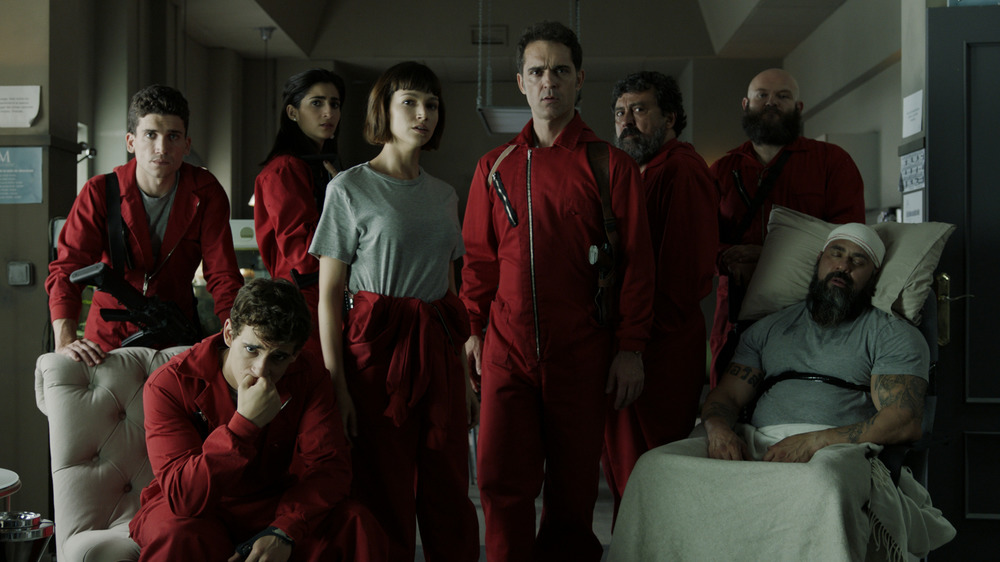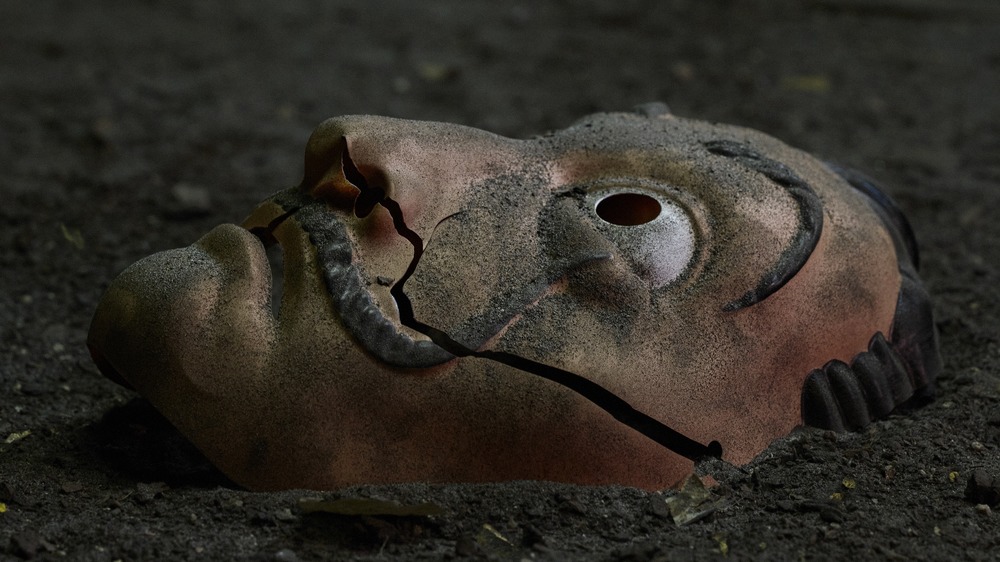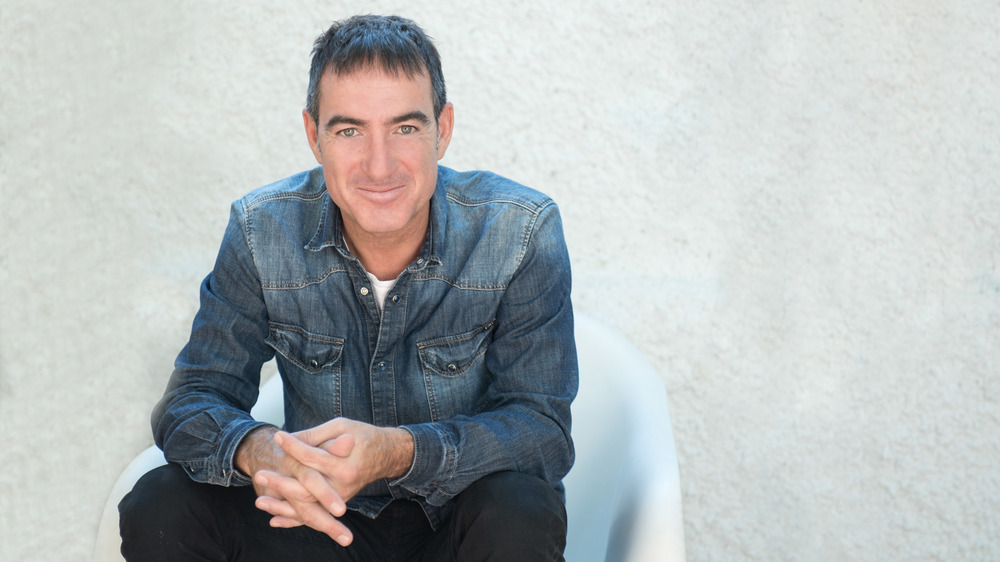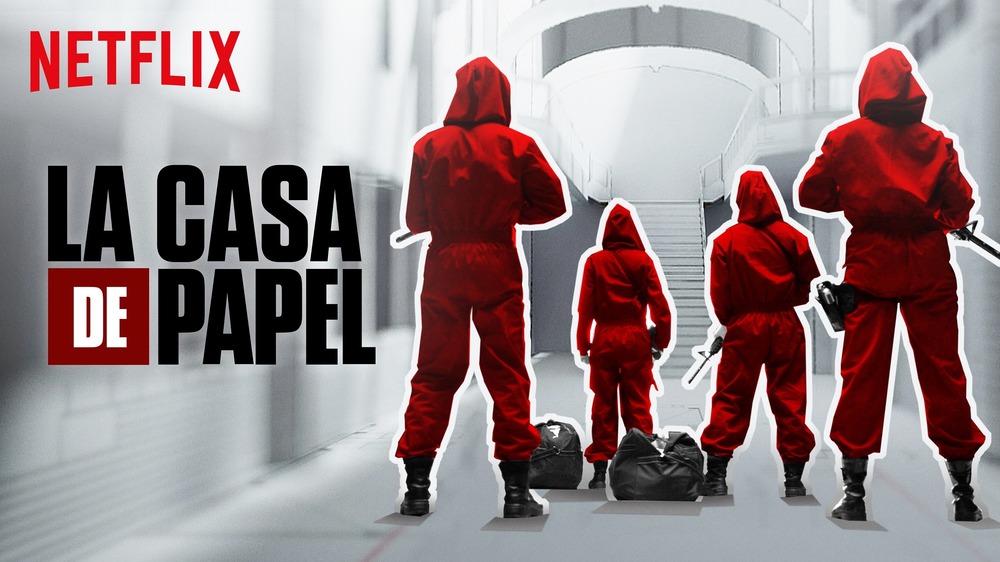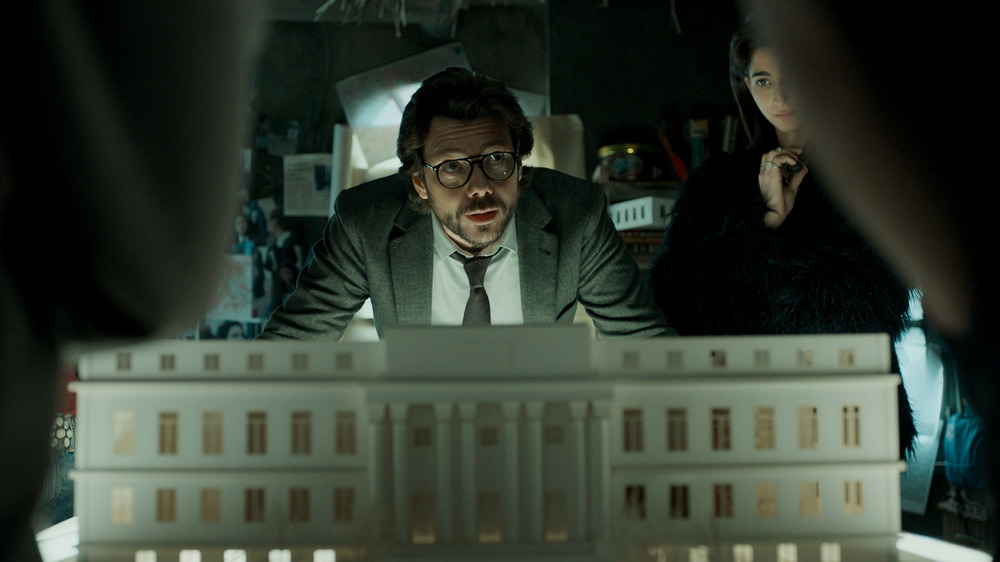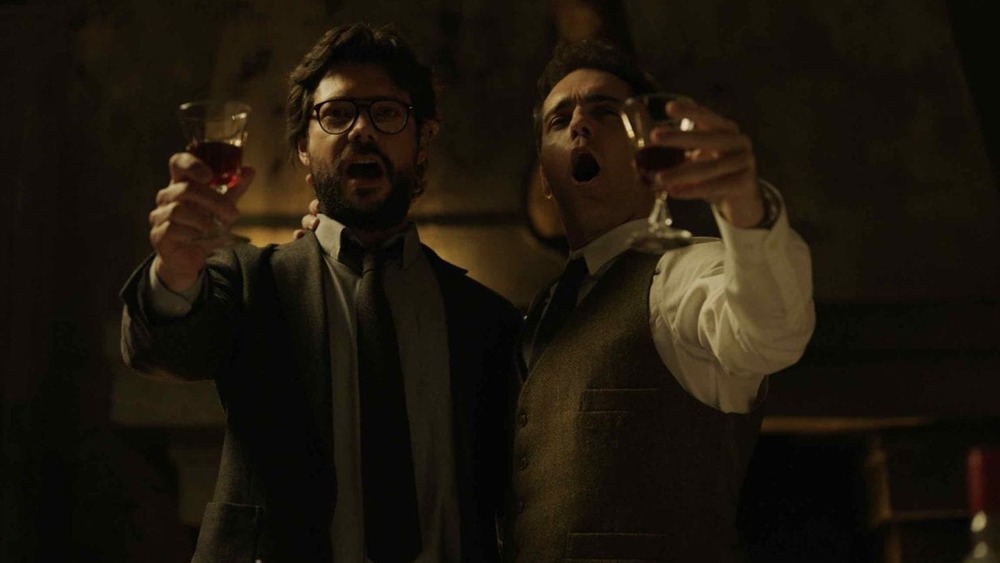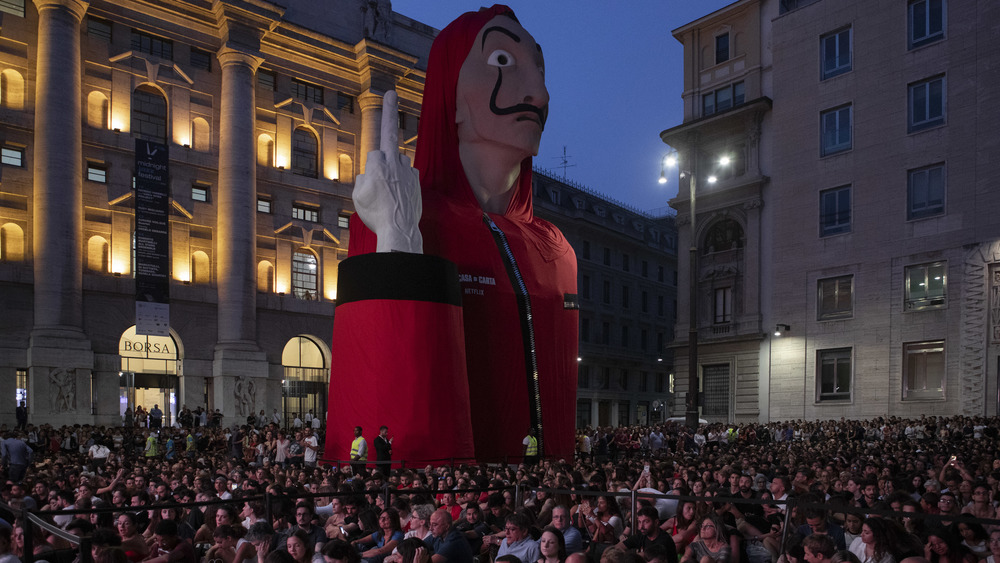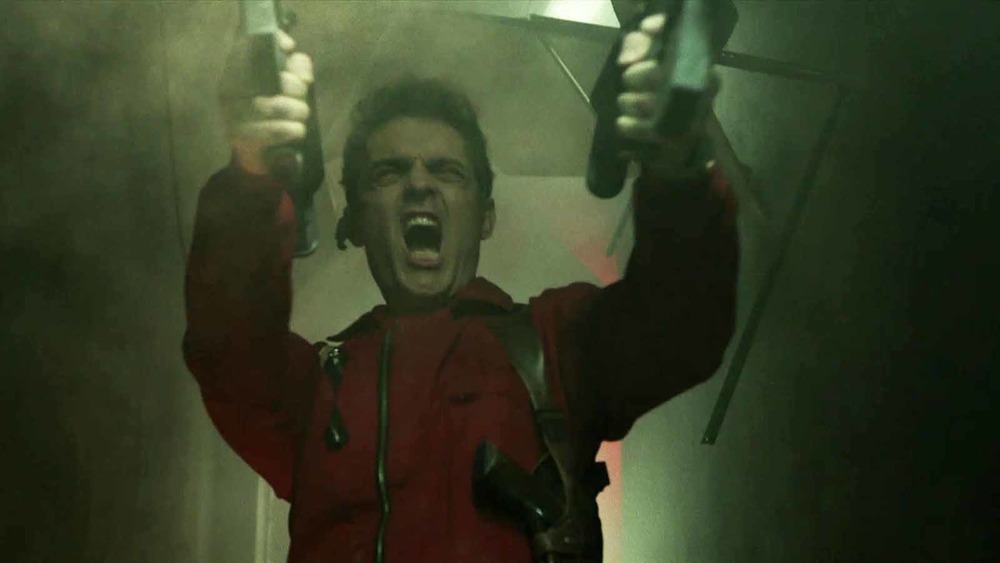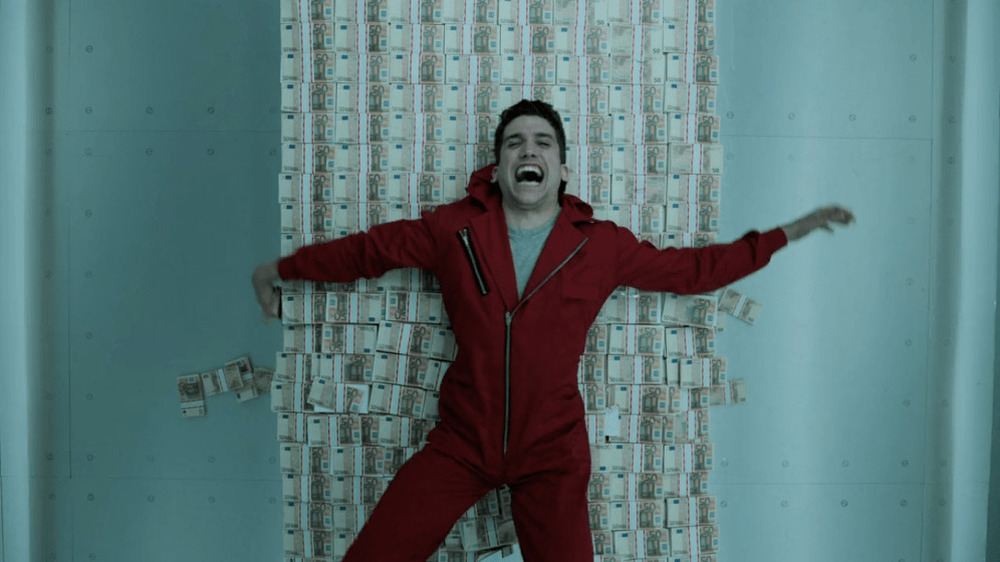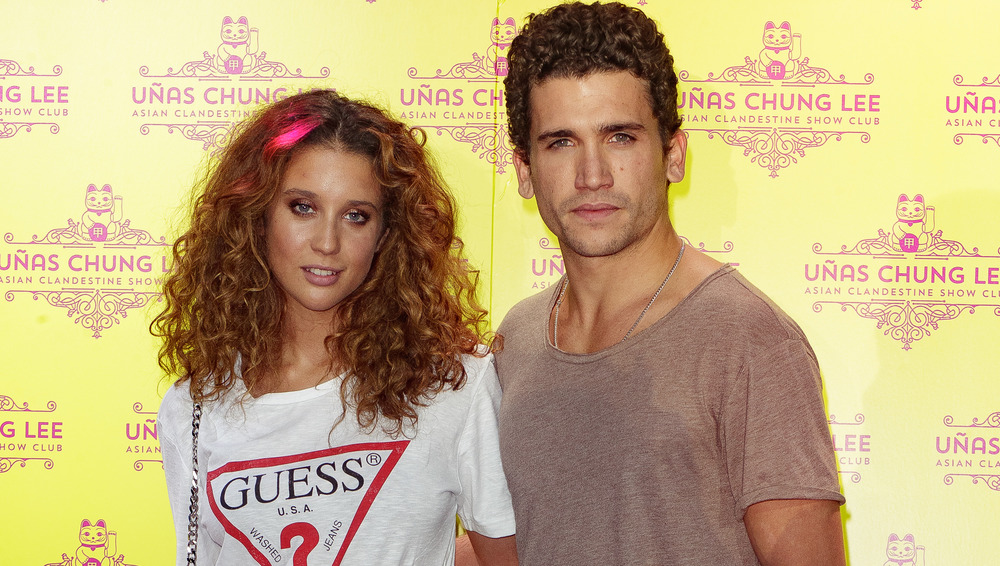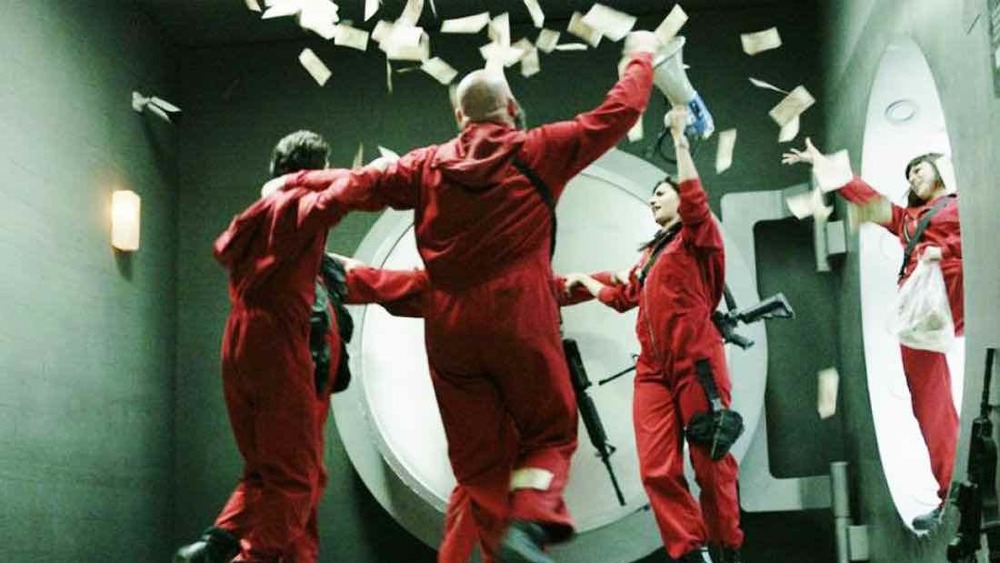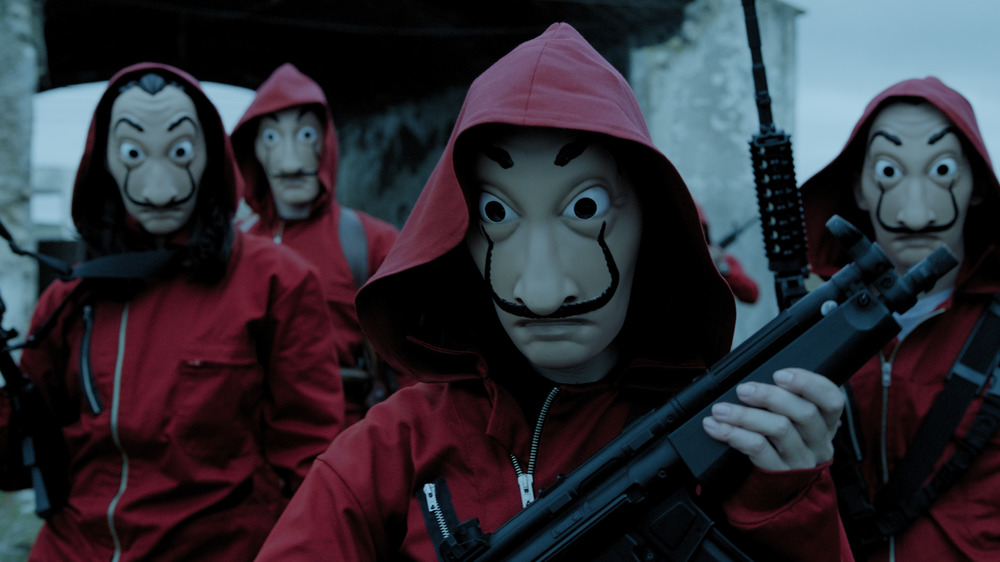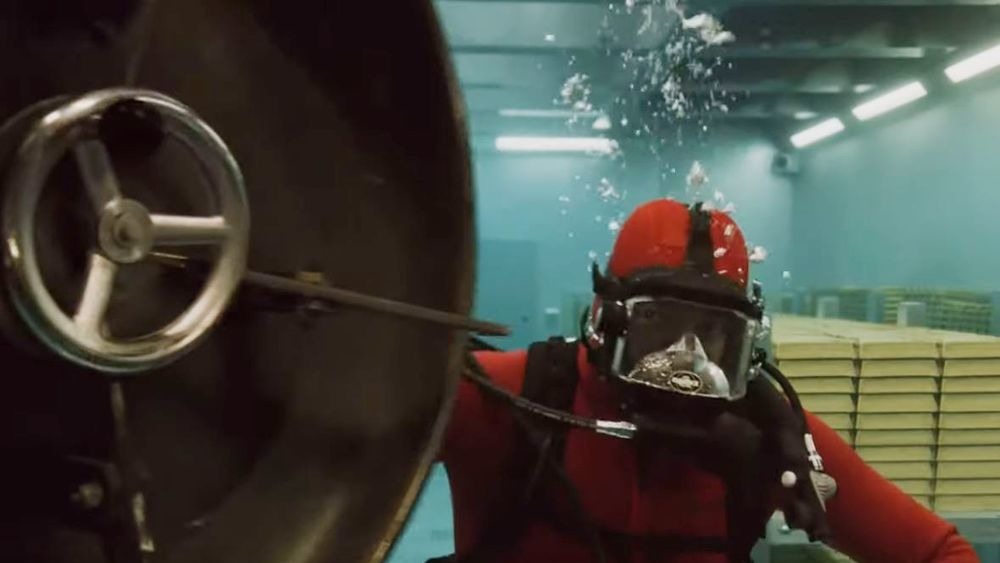13 Things You Didn't Know About Money Heist
Money Heist is the international phenomenon that almost wasn't. The story of Money Heist was almost one of a limited series in Spain whose ratings plummeted over its run before it fell into obscurity. Then Netflix picked it up, and everything changed. The show exploded internationally over the streaming service. The red jumpsuits and Dalí masks worn by the heist gang appeared at parties, protests, and football (soccer) matches, popping up in places as diverse as Paris, Brazil, and Saudi Arabia.
The show climbed in popularity to become Netflix's #1 show in many international markets and to rank in the top ten in nearly every global market. In April 2020, it was Netflix's most in-demand series. And with that came the announcement that Netflix would be producing new seasons and a whole new heist, this one even bigger than the first. So far, two new blocks of episodes have dropped, with another on the way. While the chess game unfolding between the thieves and the authorities has captivated the world, the behind-the-scenes story is almost as captivating.
Money Heist was a flop
Originally conceived as a limited-run series, Money Heist premiered to over four million viewers on the Spanish network Antena 3 as Casa de Papel (House of Paper). It sustained those numbers for the next few episodes, but then viewership plummeted. According to Money Heist head writer and producer Javier Gómez Santander, "Contrary to what it seems, the life of the series is a story of failure, Antena 3 cut the number of planned chapters." It was eventually canceled, and that would have been the end of the story.
Netflix picked up the show but without much fanfare. It kept it as just another of its properties without promotion or attention. The cast and creative team began looking for other jobs when suddenly, they started noticing their social media numbers increasing rapidly. On Netflix, Case de Papel, renamed Money Heist, had been exploding internationally, and seemingly overnight, the Spanish "failure" had become a global hit. Netflix quickly signed series creator Álex Pina to a wider deal and brought the gang back for another heist.
Netflix bought Money Heist for $2
As mentioned above, Netflix is the key to this story of a hit series rising from the ashes. Shows have come back from the dead, some due to popularity found in syndication, others after being released on DVD. These other series were saved by faithful fans, but most of them cost more than $2, which was what Netflix paid for the rights to Money Heist.
The streaming giant rolled Money Heist out without advertising or promotion — Netflix's other costs associated with Money Heist included translation and some basic restructuring of the episodes, but that was about it. Then the series picked up in places other than its home country of Spain. In fact, it absolutely exploded across not only Spanish-speaking markets but English-speaking ones as well. Given the overnight international popularity of the original episodes with such a limited investment, Netflix signed series creator Álex Pina to an exclusive deal. And it also signed up to produce two more seasons (or "parts") with Pina and his team, albeit at a considerably higher budget.
Casa de Papel was originally only one season
In Spain, it is standard for TV episodes to last 70 minutes. Plus, Casa de Papel was conceived as a one-season limited run told in two parts, although since it was written as it went on, the ending was cut short of what the producers wanted. Unlike other Spanish series and even many American network shows, Casa de Papel's storyline continued episode-to-episode, as opposed to the episodes being self-contained. This held through a nine-episode Part 1 and a six-episode Part 2 for a 15-episode season.
When Netflix picked it up, the streaming company cut the episodes to match standard American TV episode lengths of 40-50 minutes (based on the previous American status quo of an hourlong show with commercials). It retitled the series Money Heist in English and then rolled it out as parts with no mention of "season" so as to avoid confusion. Part 1 now lasted 13 episodes, and Part 2 lasted nine, for a total of 22 episodes. Parts 3 and 4, produced by Netflix, were both eight episodes. Often, people see Part 1 and Part 2 as "Season 1" and "Season 2."
Money Heist wasn't filmed at the Royal Mint of Spain
The interior of the Royal Mint was a set built in a studio in Colmenar Viejo, north of Madrid. This made it much easier to set up cameras and angles for camera crews and gave more flexibility as far as shots. Also, the actual Royal Mint wouldn't be a good place for filming, given the fact that it has actual business to do, and that business is of a very important and delicate nature. Unlike the interior built for the show, the exteriors were real locations in Madrid — just not the Royal Mint.
The exterior front of the Royal Mint was actually that of the Consejo Superior de Investigaciones Científicas (CSIC, or, in English, the Spanish National Research Council) in Madrid. The rooftop scenes were filmed at the Universidad Politécnica de Madrid (UPM) School of Aeronautics and Space Engineering. Parts 3 and 4 replicated this method for the Bank of Spain. The interior was a Netflix set, though the exterior was actually the Ministerio de Fomento (Ministry of Public Works and Transport).
Bella Ciao was picked from a hype mix
Javier Gómez Santander, Money Heist's head writer and an executive producer, was working with the writing team to find a song that could be used and echoed during the show's celebratory scenes. During the process, Santander put on a mix of songs that inspired his writing and, upon hearing "Bella Ciao," decided that it fit the mood perfectly. Not only was it optimistic and moving, but it was also a song of rebellion.
With its roots as an Italian folk song used as inspiration for the Italian anti-fascist resistance during World War II, it fit perfectly with the gang's position as more than just thieves. The idea of the heist as part of a resistance against the capitalist institutions that sank the global economy in 2008 turned them into heroes for the common man both on- and off-screen. "Bella Ciao" is the song of "la resistencia," and since Money Heist came out, it has been sung globally during protests, soccer games, and more. There have also been loads of remixes and new recordings of the old song, with versions ranging from acoustic ditties to electro dance hall remixes.
The lives of the actors have followed their characters – from obscurity to international superstardom
The cast of Casa de Papel was mostly unknown outside of Spain before Money Heist became an international name. In the documentary Money Heist: The Phenomenon, the actors describe watching their number of Instagram followers growing exponentially. Úrsula Corberó, who plays narrator and series lead Tokio, has over 20 million Instagram followers as of January 2021, more than Spanish celebrities Penélope Cruz, Antonio Banderas, and Rafael Nadal combined. Álvaro Morte, who plays the Professor, was number three on the list of most famous Spanish entertainers as of January 2021, with 11 million followers.
This popularity also presented challenges to the filming of Part 3. As shown in Money Heist: The Phenomenon, when they started filming at the Piazza del Duomo, there was already a massive crowd disrupting shooting. After the shoot, Morte and Pedro Alonso, who plays Berlín, went over to greet their fans. They were then mobbed and crowded to the point that it was a little frightening. The main actors are now seemingly as well-known internationally as the characters they play, who pulled off the largest (fictional) robbery in history.
A dying ambition
An early pilot had the reason for the heist being that the members had terminal illnesses. Since there were 52 versions of the pilot, many different angles for the heist had been explored, and there was even a different name at first (Los Desahuciados, or "The Outcasts/Convicts" because of their shared backgrounds). The terminal illness angle at first helped to explain why they were so willing to take on such a risky heist.
Obviously, the idea that many (if not all) of the gang members were motivated by a terminal illness was dropped. It would have taken the whole heist in a different direction if they all had, at best, a tenuous future. However, this idea obviously was applied to one character: Berlín, the brother of the Professor and captain inside the mint. His terminal illness in part inspired the Professor to stage the heist and also led to one of the most memorable scenes, where Berlín happily gives his life in a shootout with the cops so the rest can escape.
Making money
The gang prints and then takes out nearly a billion euros in their heist of the Royal Mint. In Part 3, the heist of the Bank of Spain begins with the dropping of 150 million euros over Madrid. There is a lot of money flying around and being run over high-speed printers in all four parts of Money Heist, so much that money might as well be considered another character. Obviously, they couldn't use real money for all of these scenes, but the centrality of money to Money Heist means that it had to be as accurate as possible.
In the first heist, the scene of thousands of euros running on a massive printing press is about as memorable as it gets, as are the scenes of the cast rolling around in money. But that printing actually happened on a newspaper press, one owned by national Spanish newspaper ABC. And to simulate the money itself, the producers used newspaper.
Stockholm syndrome
In Part 3, everybody laughs when the Professor says there should be no relationships in the heist. That's because the Professor has gotten together with Raquel Murillo, the investigator who was trying to foil the first heist and, in the process, fell in love with and joined the Professor. Then there's the fact that the driver of Part 3 is the rescue of Río at the urging of his girlfriend Tokio, after the two got together during the first heist. And finally, there's Stockholm, the hostage from the first heist who fell in love with Denver, fired automatic weapons at the cops as they escaped, came with him to his hideaway, and joined the gang for the next heist.
There is great interest in the real-world relationship between Úrsula Corberó, who plays Tokio, and Miguel Herrán, who plays Río. Their on-screen romance smolders, and they've played up their chemistry over social media. Alas, they aren't together. But in real life, Denver ended up with a hostage. Jaime Lorente, who plays Denver, had been dating Maria Pedraza, who played "star hostage" Allison Parker, since the first season finished shooting, if not before. They met on a show they both starred in before Money Heist, called Elite. As of January 2021, they've reportedly split up, but there've been breakup rumors before. If they are broken up, you could chalk that up to the stress of a relationship born during a heist.
The international popularity of Parts 1 and 2 presented difficulty for Parts 3 and 4
The writers of Money Heist were having trouble developing the concepts and story for Parts 3 and 4 with all the attention surrounding the original episodes. For that reason, they went to Colombia to do their writing out of the public eye. This session occurred very close to where Part 3 starts with Río and Tokio on an island off the coast of Panama.
The writers could no longer operate undisturbed in Madrid, and they wanted to explore the fact that there was more for the main characters to say, very tough when the world was still abuzz over the exploits of the first heist. To give the characters more depth, they decided, they'd need a heist where more can and does go wrong. Before agreeing to develop the new parts of what had originally been a self-contained story, series developer Álex Pina ensured that Netflix would allow them to depart from the pattern set in the first two parts, that of a well-organized heist that stays mostly to the plan.
The new season began with chaos on a Caribbean island involving Río, the police, and a moment of truth with a rocket launcher.
Money Heist has inspired actual robberies
On December 1, 2020, a well-executed bank robbery in Criciuma, Brazil, ended with bills exploding onto the street, similar to the opening of Part 3. The robbers were well-trained and well-armed, and that scattering of bills was used as a diversion to allow them to escape. There were arrests of people grabbing money from the street but no arrests of the robbers themselves.
In August 2018, two Moroccans were caught after making off with $15,000 from a hotel and a store. They wore Dalí masks, executed their robberies with the utmost professionalism, and were reported to have been inspired by the series. There have been other robberies as well, especially many in Europe, thought to be inspired by the series. While some connections have been confirmed and others only rumored, needless to say, if you're a robber, the Professor and company are a good example to follow.
More than just an outfit
The distinct red coveralls and Dalí masks have inspired everything from Halloween costumes to the outfits of protesters. But the costume is more than just an arbitrary aesthetic choice made to look cool.
Yes, the red color was chosen to stand out from the dark, drab colors of the interior set. But the red was also inspired by the fact that the color has traditionally been related to passion, alertness, love, and death. Plus, red has been a color associated with revolution from Paris to Cuba.
As for the mask, the team first thought of using a mask with Don Quixote's face. These robberies are somewhat Quixotic given their odds, and there's even a nod to the great Spanish windmill tilter in Part 4, episode 2, when we see the Professor passing the actual windmills of La Mancha. But the team finally decided that Salvador Dalí was more modern and recognizable, and he was also associated with Dadaism and its rejection of modern mainstream capitalism.
More money, more problems
Parts 1 and 2 were filmed with the limited budget of a Spanish TV show with not a lot of hope for international distribution. Since the show "ended" with a cancellation, they didn't even have enough money to film the final scene in the Philippines but had to make Madrid look like Palawan and CGI in an ocean. Then Netflix signed on, and the bar was raised for Parts 3 and 4.
The new budget meant they could rent islands and military helicopters, but it also meant they would be able to shoot more complex scenes, which presented greater difficulties. The scene where the Professor drops money all over Madrid was actually filmed in Callao Square, Madrid's own version of Times Square. There were problems with banknotes getting stuck in fans, with a rainstorm coming in to drench the bills, and even with losing the greenscreen background on the giant screens in the square that were supposed to show the Professor's message. Then there was the scene shot in a water-filled vault, necessary since this is an actual detail of the real gold vault in the Bank of Spain.
Money Heist suddenly had a huge budget and according expectations that led to nightmare shooting days. Not only did they have to build the water-filled chamber and film in it to make it realistic, but they also had issues with the gold ingots (made of plastic) floating and then getting crushed by the pressure within the chamber.
Special thanks to Lydia Garthaia Vazquez for her assistance with this piece.
